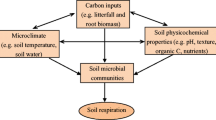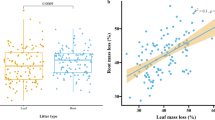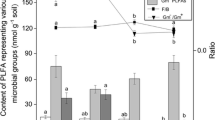Abstract
Uncertainty regarding how subalpine forest ecosystems respond to tree harvesting hinders their sustainable management and conservation strategies. To investigate the impact of oak (Quercus aquifolioides Rehd. et Wils.) harvesting and stand recovery processes on soil microbial communities and understory vegetation on the eastern Tibetan Plateau, we sampled and quantified the microbial community structure and understory vegetation in three age classes (1 year, 10 years, and 20 years since tree logging) of harvested stands and an un-harvested reference (control) stand of subalpine oak forest. Our result showed logging significantly altered the edaphic properties (p < 0.001) and shifted microbial community structure (p < 0.05), increasing the abundances of the Actinobacteria and arbuscular mycorrhizal fungi (AMF) but decreasing fungi and general, gram-positive and gram-negative bacteria. Post-harvest evolution increased the biomass of understory vegetation and reshaped its community. Fungi (18:1ω7c, 18:1ω9c) and gram-negative bacteria (18:2ω7c, cy19:0) abundances changed significantly (p < 0.01) after harvesting and during stand recovery, suggesting their potential use as indicators for post-harvest oak recovery. Structural equation modeling (SEqM) revealed that, via litter, residue, and edaphic properties, the recovery process indirectly promoted microbe abundance while the overstory vegetation regrowth inhibited the plant community’s biomass in the understory. Microbial communities only had a minor, direct effect on understory vegetation. Litter and edaphic factors played important roles in reshaping understory plant and soil microbial communities for post-harvest evolution.




Similar content being viewed by others
References
Åström M, Dynesius M, Hylander K, Nilsson C (2007) Slope aspect modifies community responses to clear-cutting in boreal forests. Ecology 88(3):749–758
Bååth E, Anderson TH (2003) Comparison of soil fungal/bacterial ratios in a pH gradient using physiological and plfa-based techniques. Soil Biol. Biochem. 35:955–963
Bååth E, Frostegård Å, Pennanen T, Fritze H (1995) Microbial community structure and pH response in relation to soil organic matter quality in wood-ash fertilized, clear-cut or burned coniferous forest soils. Soil Biol Biochem 27(2):229–240
Bao WK (2005) Structural features of Polytrichum formosum Hedw. populations along a habitat sequence of cutover restoration in the eastern Tibetan Plateau. Ecol. Res. 20:701–707
Bartels SF, Chen HY (2013) Interactions between overstorey and understorey vegetation along an overstorey compositional gradient. J. Veg. Sci. 24:543–552
Beare M, Neely C, Coleman D, Hargrove W (1991) Characterization of a substrate-induced respiration method for measuring fungal, bacterial and total microbial biomass on plant residues. Agric. Ecosyst. Environ. 34:65–73
Bergstedt J, Milberg P (2001) The impact of logging intensity on field-layer vegetation in Swedish boreal forests. Forest Ecol. Manag. 154:105–115
Bossio DA, Scow KM (1998) Impacts of carbon and flooding on soil microbial communities: phospholipid fatty acid profiles and substrate utilization patterns. Microb Ecol 35(3):265–278
Bray JR, Curtis JT (1957) An ordination of the upland forest communities of southern Wisconsin. Ecol. Monogr. 27:325–349
Busse MD, Beattie SE, Powers RF, Sanchez FG, Tiarks AE (2006) Microbial community responses in forest mineral soil to compaction, organic matter removal, and vegetation control. Can. J. Forest Res. 36:577–588
Chang SX, Weetman GF, Preston CM (1995) Soil microbial biomass and microbial and mineralizable N in a clear-cut chronosequence on northern Vancouver Island. British Columbia. Can. J. Forest Res. 25:1595–1607
Clarke KR, Somerfield PJ, Chapman MG (2006) On resemblance measures for ecological studies, including taxonomic dissimilarities and a zero-adjusted Bray–Curtis coefficient for denuded assemblages. J. Exp. Mar. Biol. Ecol. 330:55–80
Dakhil MA, Xiong QL, Farahatc EA, Zhang L, Pan KW, Pandey B, Olatunji OA, Tariq A, Wu XG, Zhang AP, Tan X, Huang D (2019) Past and future climatic indicators for distribution pattern and conservation planning of temperate coniferous forests in southwestern China. Ecol. Indic. 107:105559
Dale VH, Joyce LA, McNulty S, Neilson RP, Ayres MP, Flannigan MD, Hanson PJ, Irland LC, Lugo AE, Peterson CJ, Simberloff D, Swanson FJ, Stocks BJ, Wotton BM (2001) Climate change and forest disturbances. Bioscience 51:723–734
Decocq G, Aubert M, Dupont F, Alard D, Saguez R, Wattez-Franger A, Foucault BD, Delelis-Dusollier A, Bardat J (2004) Plant diversity in a managed temperate deciduous forest: understorey response to two silvicultural systems. J. Appl. Ecol. 41:1065–1079
Dighton, J., White Jr, J.F., White, J., Oudemans, P., 2014. The fungal community: its organization and role in the ecosystem, third ed. CRC Press, Boca Raton pp. 496–511.
Diochon A, Kellman L, Beltrami H (2009) Looking deeper: an investigation of soil carbon losses following harvesting from a managed northeastern red spruce (Picea rubens Sarg.) forest chronosequence. Forest Ecol. Manag. 257:413–420
Elliott KJ, Boring LR, Swank WT, Haines BR (1997) Successional changes in plant species diversity and composition after clearcutting a southern Appalachian watershed. Forest Ecol. Manag. 92:67–85
Feng C, Ma Y, Fu S, Chen HY (2017) Soil carbon and nutrient dynamics following cessation of anthropogenic disturbances in degraded subtropical forests. Land Degrad. Dev. 28:2457–2467
Frostegård Å, Bååth E (1996) The use of phospholipid fatty acid analysis to estimate bacterial and fungal biomass in soil. Biol. Fertil. Soils 22:59–65
Frostegård Å, Tunlid A, Bååth E (2011) Use and misuse of PLFA measurements in soils. Soil Biol. Biochem. 43:1621–1625
Gao Y.X., Li M.S., 2000. Soils of Hengduan Mountains, first ed. Science Press, Beijing pp. 41–45.
Gessner MO, Swan CM, Dang CK, McKie BG, Bardgett RD, Wall DH, Hättenschwiler S (2010) Diversity meets decomposition. Trends Ecol. Evol. 25:372–380
Grace JB, Anderson TM, Olff H, Scheiner SM (2010) On the specification of structural equation models for ecological systems. Ecol. Monogr. 80:67–87
Gracia M, Retana J (2004) Effect of site quality and shading on sprouting patterns of holm oak coppices. Forest Ecol. Manag. 188:39–49
Hammer, Ø., Harper, D., Ryan, P., 2009. PAST-Palaeontological Statistics, ver. 1.89. University of Oslo, Oslo pp. 89–96.
Hannam K, Quideau S, Kishchuk B (2006) Forest floor microbial communities in relation to stand composition and timber harvesting in northern Alberta. Soil Biol. Biochem. 38:2565–2575
Hart SA, Chen HY (2006) Understory vegetation dynamics of North American boreal forests. Crit. Rev. Plant Sci. 25:381–397
Hartmann M, Howes CG, VanInsberghe D, Yu H, Bachar D, Christen R, Nilsson RH, Hallam SJ, Mohn WW (2012) Significant and persistent impact of timber harvesting on soil microbial communities in Northern coniferous forests. ISME J. 6:2199–2218
Högberg MN, Högbom L, Kleja DB (2013) Soil microbial community indices as predictors of soil solution chemistry and N leaching in Picea abies (L.) Karst. forests in S. Sweden. Plant Soil 372:507–522
Holdena SR, Treseder KK (2013) A meta-analysis of soil microbial biomass responses to forest disturbances. Front. Microbiol. 4:163
Hylander K, Dynesius M, Jonsson BG, Nilsson C (2005) Substrate form determines the fate of bryophytes in riparian buffer strips. Ecol. Appl. 15:674–688
Idol TW, Pope PE, Ponder F (2003) N mineralization, nitrification, and N uptake across a 100-year chronosequence of upland hardwood forests. Forest Ecol. Manag. 176:509–518
Jacob M, Weland N, Platner C, Schaefer M, Leuschner C, Thomas FM (2009) Nutrient release from decomposing leaf litter of temperate deciduous forest trees along a gradient of increasing tree species diversity. Soil Biol. Biochem. 41:2122–2130
Jenkinson DS, Ladd JN, 1981. Microbial biomass in soil: measurement and turnover. In Paul, E.A., Ladd, J.N. (Ed.), Soil Biochemistry (Vol. 5, pp. 415-471)
Johnson EA, Miyanishi K (2008) Testing the assumptions of chronosequences in succession. Ecol. Lett. 11:419–431
Jurgensen M, Harvey A, Graham R, Page-Dumroese D, Tonn J, Larsen M, Jain T (1997) Impacts of timber harvesting on soil organic matter, nitrogen, productivity, and health of inland northwest forests. Forest Sci. 43:234–251
Kaiser M, Wirth S, Ellerbrock RH, Sommer M (2010) Microbial respiration activities related to sequentially separated, particulate and water-soluble organic matter fractions from arable and forest topsoils. Soil Biol. Biochem. 42:418–428
Kembel SW, Waters I, Shay JM (2008) Short-term effects of cut-to-length versus full-tree harvesting on understorey plant communities and understorey-regeneration associations in Manitoba boreal forests. Forest Ecol. Manag. 255:1848–1858
Kirby R (2006) Actinomycetes and lignin degradation. Adv. Appl. Microbiol. 58:125–168
Lamb EG, Kennedy N, Siciliano SD (2011) Effects of plant species richness and evenness on soil microbial community diversity and function. Plant Soil 338:483–495
Langenbruch C, Helfrich M, Flessa H (2012) Effects of beech (Fagus sylvatica), ash (Fraxinus excelsior) and lime (Tilia spec.) on soil chemical properties in a mixed deciduous forest. Plant Soil 352:389–403
Legendre P, Legendre L (2012) Numerical ecology. Elsevier, New York, NY
Li C, Zhang X, Liu X, Luukkanen A, Berninger F (2006) Leaf morphological and physiological responses of Quercus aquifolioides along an altitudinal gradient. Silva Fenn. 40:5–13
Li LJ, Xiong QL, Pan KW, Zhang L (2015) The responses of soil protozoan communities to Quercus aquifolioides: recovery after cutting and growing season dynamics. Biodivers. Sci. 23:793–801
Liu X, Bao WK (2014) Understory plant assemblages present distinct short-term responses to the clear-cutting of an old-growth spruce forest near an alpine timberline. Can. J. Forest Res. 44:562–571
Maillard F, Leduc V, Bach C, Reichard A, Fauchery L, Saint-André L, Buée M (2019a) Soil microbial functions are affected by organic matter removal in temperate deciduous forest. Soil Biol. Biochem. 133:28–36
Maillard F, Leduc V, Bach C, de Moraes Gonçalves JL, Androte FD, Saint-André L, Robin A (2019b) Microbial enzymatic activities and community-level physiological profiles (CLPP) in subsoil layers are altered by harvest residue management practices in a Tropical Eucalyptus grandis plantation. Microb. Ecol. 78:528–533
Mariani L, Chang SX, Kabzems R (2006) Effects of tree harvesting, forest floor removal, and compaction on soil microbial biomass, microbial respiration, and N availability in a boreal aspen forest in British Columbia. Soil Biol. Biochem. 38:1734–1744
McGuire KL, D’Angelo H, Brearley FQ, Gedallovich SM, Babar N, Yang N, Gillikin CM, Gradoville R, Bateman C, Turner BL, Mansor P, Leff JW, Fierer N (2015) Responses of soil fungi to logging and oil palm agriculture in Southeast Asian tropical forests. Microb. Ecol. 69:733–747
Moore-Kucera J, Dick RP (2008) PLFA profiling of microbial community structure and seasonal shifts in soils of a Douglas-fir chronosequence. Microb. Ecol. 55:500–511
Page-Dumroese DS, Busse MD, Overby ST, Gardner BD, Tirocke JM (2015) Impacts of forest harvest on active carbon and microbial properties of a volcanic ash cap soil in Northern Idaho. Open J. Soil Sci. 5:11–19
Paillet Y, Bergès L, Hjältén J, Ódor P, Avon C, Bernhardt-Römermann M, Bijlsma R-J, De Bruyn LUC, Fuhr M, Grandin ULF, Kanka R, Lundin L, Luque S, Magura T, Matesanz S, Mészáros I, Sebastià MT, Schmidt W, Standovár T, Tóthmérész B, Uotila A, Valladares F, Vellak KAI, Virtanen R (2010) Biodiversity differences between managed and unmanaged forests: meta-analysis of species richness in Europe. Conserv. Biol. 24:101–112
Ponder F, Fleming RL, Berch S, Busse MD, Elioff JD, Hazlett PW, Kabzems RD, Kranabetter JM, Morris DM, Page-Dumroese D (2012) Effects of organic matter removal, soil compaction and vegetation control on 10th year biomass and foliar nutrition: LTSP continent-wide comparisons. Forest Ecol. Manag. 278:35–54
Powers RF, Scott DA, Sanchez FG, Voldseth RA, Page-Dumroese D, Elioff JD, Stone DM (2005) The North American long-term soil productivity experiment: findings from the first decade of research. Forest Ecol. Manag. 220:31–50
Reich PB, Oleksyn J, Modrzynski J, Mrozinski P, Hobbie SE, Eissenstat DM, Chorover J, Chadwick OA, Hale CM, Tjoelker MG (2005) Linking litter calcium, earthworms and soil properties: a common garden test with 14 tree species. Ecol. Lett. 8:811–818
Roberts MR (2007) A conceptual model to characterize disturbance severity in forest harvests. Forest Ecol. Manag. 242:58–64
Schmalholz M, Hylander K (2011) Microtopography creates small-scale refugia for boreal forest floor bryophytes during clear-cut logging. Ecography 34:637–648
Singh BK, Bardgett RD, Smith P, Reay DS (2010) Microorganisms and climate change: terrestrial feedbacks and mitigation options. Nat. Rev. Microbiol. 8:779–790
Tan X, Chang SX, Kabzems R (2008) Soil compaction and forest floor removal reduced microbial biomass and enzyme activities in a boreal aspen forest soil. Biol. Fert. Soils 44:471–479
Turetsky MR (2003) The role of bryophytes in carbon and nitrogen cycling. Bryologist 106:395–409
Vucetich JA, Waite TA, Qvarnemark L, Ibargüen S (2010) Population variability and extinction risk. Conserv. Biol. 14:1704–1714
Walker LR, Wardle DA, Bardgett RD, Clarkson BD (2010) The use of chronosequences in studies of ecological succession and soil development. J. Ecol. 98:725–736
Walmsley J, Jones D, Reynolds B, Price M, Healey J (2009) Whole tree harvesting can reduce second rotation forest productivity. Forest Ecol. Manag. 257:1104–1111
Wardle DA, Jonsson M, Bansal S, Bardgett RD, Gundale MJ, Metcalfe DB (2012) Linking vegetation change, carbon sequestration and biodiversity: insights from island ecosystems in a long-term natural experiment. J. Ecol. 100:16–30
Wilhelm RC, Cardenas E, Leung H, Szeitz A, Jensen LD, Mohn WW (2017) Long-term enrichment of stress-tolerant cellulolytic soil populations following timber harvesting evidenced by multi-omic stable isotope probing. Front. Microbiol. 8:537
Liu X, Bao WK (2014) Understory plant assemblages present distinct short-term responses to the clear-cutting of an old-growth spruce forest near an alpine timberline. Can J For Res 44(6):562–571
Xiong QL, Pan KW, Zhang L, Wang YJ, Li W, He XJ, Luo HY (2016) Warming and nitrogen deposition are interactive in shaping surface soil microbial communities near the alpine timberline zone on the eastern Qinghai–Tibet Plateau, southwestern China. Appl. Soil Ecol. 101:72–83
Xiong QL, Xiao Y, Halmy MW, Dakhil MA, Liang PH, Liu CG, Zhang L, Pandey B, Pan KW, Kafraway SB, Chen J (2019) Monitoring the impact of climate change and human activities on grassland vegetation dynamics in the northeastern Qinghai-Tibet Plateau of China during 2000–2015. J Arid Land 11:637–651
Xiong QL, Luo XJ, Liang PH, Xiao Y, Xiao Q, Sun H, Pan KW, Wang LX, Li LJ, Pang XY (2020) Fire from policy, human interventions, or biophysical factors? Temporal–spatial patterns of forest fire in southwestern China. Forest Ecol. Manag. 474:118381
Zenner EK, Kabrick JM, Jensen RG, Peck JE, Grabner JK (2006) Responses of ground flora to a gradient of harvest intensity in the Missouri Ozarks. Forest Ecol. Manag. 222:326–334
Zhang R, Koike T, Xu X, Ma Y, Yang K (2012) A China-Japan cooperative JICA atmospheric observing network over the Tibetan plateau (JICA/Tibet project): an overviews. J. Meteorol. Soc. Jpn. 90:1–16
Zhong WH, Gu T, Wang W, Zhang B, Lin XG, Huang QR, Shen WS (2010) The effects of mineral fertilizer and organic manure on soil microbial community and diversity. Plant Soil 326:511–522
Acknowledgments
The authors also thank Dr. Mingrui Deng and Prof. Pinghan Liang for their help during the preparation of the manuscript. We also thank Charlesworth Author Services (http://www.cwauthors.com) for polishing language in this manuscript. We appreciate the helpful observations of the chief editor and two anonymous reviewers on a previous version of this article.
Funding
This research was funded by the National Natural Science Foundation of China (grant number 31700544), the National Key Research and Development Program of China (grant number 2020YFE0203200), the Sichuan Sci & Tech Department (grant number 2020YFS29), the Chinese Academy of Sciences (CAS) “Light of West China” Program (grant number 2016XBZG_XBQNXZ_B_005), the CAS Key Laboratory of Mountain Ecological Restoration and Bioresource Utilization & Ecological Restoration Biodiversity Conservation Key Laboratory of Sichuan Province Program (grant number kxysws1901), the CAS Research and Development of Scientific Instrument and Equipment Program (grant number YJKYYQ20190064), and the Youth Innovation Promotion Association CAS (grant number 2021372).
Author information
Authors and Affiliations
Contributions
All authors worked together to design this study. QX and LL collected the data and did the analysis. QX wrote the draft of this paper. All authors contributed substantially to modify and revise this paper.
Corresponding authors
Ethics declarations
Conflict of interest
The authors declare that there is no conflict of interests.
Additional information
Responsible Editor: Philippe Garrigues
Publisher’s note
Springer Nature remains neutral with regard to jurisdictional claims in published maps and institutional affiliations.
Electronic supplementary material
ESM 1
(DOC 1.26 mb)
Rights and permissions
About this article
Cite this article
Xiong, Q., Li, L., Luo, X. et al. Driving forces for recovery of forest vegetation after harvesting a subalpine oak forest in eastern Tibetan Plateau. Environ Sci Pollut Res 28, 67748–67763 (2021). https://doi.org/10.1007/s11356-021-15367-3
Received:
Accepted:
Published:
Issue Date:
DOI: https://doi.org/10.1007/s11356-021-15367-3




